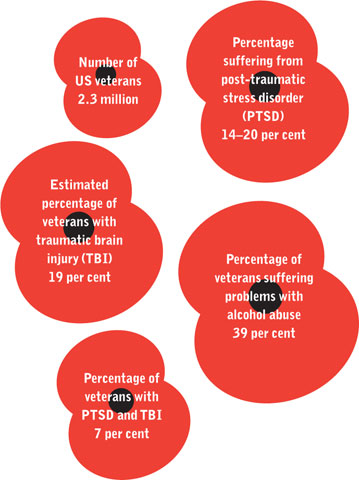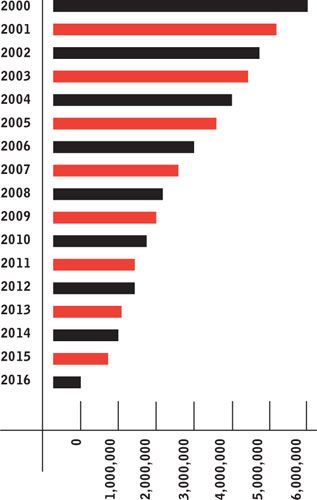The Book of the Poppy (11 page)
Read The Book of the Poppy Online
Authors: Chris McNab

US VETERANS STATISTICS – IRAQ AND AFGHANISTAN

Today we have far better understanding of veterans’ needs, experiences and problems, but we must not be complacent. Amongst veterans of the Afghanistan and Iraq conflicts, rates of suicide and violence remain worryingly high in men plagued by PTSD. For example, in the United States the US Department of Veteran Affairs estimates that PTSD afflicts:
![]() Almost 31 per cent of Vietnam veterans
Almost 31 per cent of Vietnam veterans
![]() As many as 10 per cent of Gulf War (
As many as 10 per cent of Gulf War (
Desert Storm
) veterans
![]() 11 per cent of veterans of the war in Afghanistan
11 per cent of veterans of the war in Afghanistan
![]() 20 per cent of Iraqi war veterans
20 per cent of Iraqi war veterans
The rates in British veterans of Afghanistan and Iraq do not appear to be quite as high, but there are still issues to be addressed. For example, a
Sunday Mirror
report in 2013 revealed that an estimated 9,000 military veterans were homeless on Britain’s streets, the ex-soldiers making up 10 per cent of the homeless total. Furthermore, in 2012 forty-four British soldiers were killed in Afghanistan, but fifty serving soldiers or veterans took their own lives in the same year.
Another challenge of modern war is helping soldiers who have been injured get back into work and family life. Across the coalition forces, thousands of men and women have suffered limb amputations, head trauma or other debilitating injuries. We should never underestimate the challenges facing such people. In many cases, particularly those involving limb amputations, the wounded soldier has to adjust to an entirely new type of existence, in which simple and once-familiar physical tasks become alien and exhausting. Studies in the United States have shown that 25 per cent of combat amputees typically suffer from PTSD, and more than 35 per cent from chronic depression. Thus while mobility can usually be restored by intelligent aftercare and the application of excellent prosthetics, providing the support to get wounded soldiers back into work and society at large is expensive, time-consuming and utterly justified.
Of course, it is not just military personnel who experience the consequences of war. For every soldier deployed, their families must also adjust to the mental hardships of not seeing a son, daughter, spouse or parent for months on end, and worrying about their exposure to danger. The families have to cope with the practical demands of separation, frequently involving money worries and the need to take over responsibilities previously performed by their partners. If a soldier returns home injured, then the family must also reconfigure their lives. If a soldier is killed, the family has to cope with both the tremendous and enduring shock of grief, together with their worries for the future.
RESPONDING TO NEED
As we have seen, the military community has its vulnerabilities, as well as its multitude of strengths. Yet if we look across Britain, and across history, we find plenty of encouraging examples of men, women and children who devote their time, money and energy to helping this vital sector of society. During and after the First World War, charities for military servicemen proliferated. For example, in 1915 Sir Cyril Arthur Pearson, a newspaper and publishing magnate, established a hostel for blinded soldiers in Bayswater Hill, London. (Pearson had special sympathies with the blind, having lost his sight to glaucoma in the early 1900s.) The hostel focused upon the men’s rehabilitation into the workforce, building up their physical strength and emotional resilience. In 1923 this charity was known as the St Dunstan’s Home, and it survives to this day in the form of Blind Veterans UK.
The issue of rehabilitating the huge numbers of paraplegics was further embraced by the charitable sector. ‘Curative workshops’ appeared, in which volunteers assisted wounded soldiers in regaining their physical fitness (using specially adapted gym equipment). Other groups took a different approach. The Chailey and Agnes Hunt’s Orthopedic Hospital, for example, specialized in the care of disabled children. During the war, however, it also began to look after crippled soldiers. One interesting element of its work was to pair the wounded soldier with a child, and make the soldier act as an inspiration and help to the young person.
Also in 1915, the Star & Garter Committee was established under the auspices of the British Red Cross. The focus of the Committee was the support and rehabilitation of severely disabled veterans, and the purchase of the Star & Garter Hotel on Richmond Hill gave the organisation its first premises as well as inspiring its name. Some sixty-five wounded veterans were admitted in 1916 (the average age was 22), and the charity’s volunteers either helped them back into their previous lives or provided a meaningful existence within the home. As with the St Dunstan’s Home, these early efforts were just the start of a long history of support, and today the Royal Star & Garter Homes deliver nursing and medical care to ex-service personnel. Not all work with disabled veterans was performed by the voluntary sector. In 1919 the government put in place the King’s National Roll Scheme (KNRS), a voluntary scheme that encouraged companies with more than ten employees to employ at least 5 per cent of their workforce from disabled servicemen. The scheme was a success, employing 89,000 people in its first year and running until 1944 (when the Disabled Persons’ Employment Act was brought in).
As we have seen, the motivation to help ex-servicemen and women flowered strongly in the First World War, and has continued to this day. The Royal British Legion is a case in point. The vast fundraising efforts of The Royal British Legion are focused on supporting millions of veterans and serving members of the armed forces, plus their families. The forms that this help can take are as varied as the lives of the military community. For families suffering bereavement, The Royal British Legion provides advice on dealing with the legal complexities of inquiries and inquests, or financial support if required. Its services for veterans include help with setting up a business (through the ‘Be the Boss’ schemes), grants and loans, advice about compensation claims, or assistance with suitable care-home facilities for older veterans.
Some of the most important support work, however, continues to focus on the treatment and rehabilitation of wounded soldiers. For those soldiers suffering from serious wounds, the road to recovery is a long one, requiring a patient human network to help at every stage of progression. The British Ministry of Defence leads the Defence Recovery Capability, which works in partnership with The Royal British Legion, Help for Heroes and other charities and agencies to help wounded military personnel gain the support they need to regain independence and either return to service life or enter work in the civilian world. Many of the veterans go to one of several Personnel Recovery Centres (PRCs) dotted around the UK, where they acquire first-rate physical, mental and vocational help. On average, a resident of a PRC will stay for four months, but the organisations do not set limits on recovery – they will devote as much time as it takes.
BRITISH TROOPS ADMITTED TO FIELD HOSPITAL, 2006–2013

A key to aiding the recovery of a soldier, sailor or airman is often to tap into the qualities that brought them into the military in the first place. Service personnel tend to be highly motivated by physical and mental challenges, especially with a degree of competition involved. To see how this motivation is applied to wounded personnel, we need only look at the Battle Back Centre, based at the National Sports Centre, Lilleshall, West Midlands. This invaluable institution focuses on getting recovering personnel involved in a variety of sports, in the process confronting and often overcoming the feared limitations of their injuries. Sporting activities include climbing, watersports, caving, wheelchair basketball, clay pigeon shooting and archery, and some 600 veterans pass successfully through the centre every year.
DECLINE IN US SECOND WORLD WAR VETERANS, 2000–16
